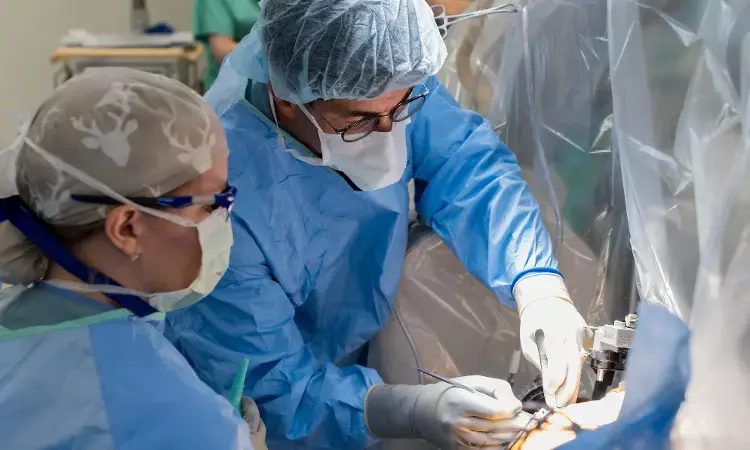- Home
- Medical news & Guidelines
- Anesthesiology
- Cardiology and CTVS
- Critical Care
- Dentistry
- Dermatology
- Diabetes and Endocrinology
- ENT
- Gastroenterology
- Medicine
- Nephrology
- Neurology
- Obstretics-Gynaecology
- Oncology
- Ophthalmology
- Orthopaedics
- Pediatrics-Neonatology
- Psychiatry
- Pulmonology
- Radiology
- Surgery
- Urology
- Laboratory Medicine
- Diet
- Nursing
- Paramedical
- Physiotherapy
- Health news
- Fact Check
- Bone Health Fact Check
- Brain Health Fact Check
- Cancer Related Fact Check
- Child Care Fact Check
- Dental and oral health fact check
- Diabetes and metabolic health fact check
- Diet and Nutrition Fact Check
- Eye and ENT Care Fact Check
- Fitness fact check
- Gut health fact check
- Heart health fact check
- Kidney health fact check
- Medical education fact check
- Men's health fact check
- Respiratory fact check
- Skin and hair care fact check
- Vaccine and Immunization fact check
- Women's health fact check
- AYUSH
- State News
- Andaman and Nicobar Islands
- Andhra Pradesh
- Arunachal Pradesh
- Assam
- Bihar
- Chandigarh
- Chattisgarh
- Dadra and Nagar Haveli
- Daman and Diu
- Delhi
- Goa
- Gujarat
- Haryana
- Himachal Pradesh
- Jammu & Kashmir
- Jharkhand
- Karnataka
- Kerala
- Ladakh
- Lakshadweep
- Madhya Pradesh
- Maharashtra
- Manipur
- Meghalaya
- Mizoram
- Nagaland
- Odisha
- Puducherry
- Punjab
- Rajasthan
- Sikkim
- Tamil Nadu
- Telangana
- Tripura
- Uttar Pradesh
- Uttrakhand
- West Bengal
- Medical Education
- Industry
External concurrent occipital and trigeminal neurostimulation relieves migraine pain: Study

USA: In a randomized environment, external concurrent occipital and trigeminal neurostimulation offered quick and lasting relief and freedom from migraine pain and accompanying symptoms, says an article published in Headache.
Patients with migraine who are resistant to first-line medications or who choose not to receive pharmaceutical therapy frequently employ non-invasive neuromodulation devices stimulating a single peripheral nerve or anatomic distribution. In an invasive situation, concurrent occipital and trigeminal stimulation was documented; nevertheless, the safety cost surpassed the effectiveness benefit. Stewart J. Tepper and colleagues carried out this study in order to assess the effectiveness and safety of an external concurrent occipital and trigeminal device in the acute treatment of migraine
The International Classification of Headache Disorders (2018) diagnostic criteria for migraine with or without aura, 1-6 migraine episodes per month, and other headaches no more than 6 days per month were satisfied by patients 18 years of age or older who qualified. 109 of the 131 individuals with an intention to treat were treated for at least one migraine attack.
The primary effectiveness outcome was a decrease in migraine headache intensity (pain alleviation) 2 hours after the start of therapy. The secondary objectives were pain reduction at 1 hour, pain independence, and relief of the most troublesome symptom at 2 hours after treatment started. One of the exploratory objectives was persistent pain freedom 24 hours after therapy began and relief from the most troublesome symptom at 2 hours.
The key findings of this study were as follow:
1. In the active arm, 60% of patients reported pain alleviation at 2 hours following the start of the first qualifying treatment, compared to 37% in the control arm (primary outcome).
2. 46% of individuals in the active arm and 12% of participants in the sham arm experienced pain relief for two hours without rescue medicine.
3. 4.25 times more individuals in the active arm than in the sham arm reported pain relief at 2 hours after the therapy and again at 24 hours.
4. There was a statistically significant difference of 28%.
5. The proportion of subjects free from pain and the most annoying symptom 2 hours after the stimulation varied by a factor of 4.25.
6. There were no severe or significant adverse effects.
In conclusion, the Authors found that external concurrent occipital and trigeminal neurostimulation appear to be a safe and effective alternative to the existing acute migraine therapies.
Reference:
Tepper, S. J., Grosberg, B., Daniel, O., Kuruvilla, D. E., Vainstein, G., Deutsch, L., & Sharon, R. (2022). Migraine treatment with external concurrent occipital and trigeminal neurostimulation—A randomized controlled trial. In Headache: The Journal of Head and Face Pain. Wiley. https://doi.org/10.1111/head.14350
Neuroscience Masters graduate
Jacinthlyn Sylvia, a Neuroscience Master's graduate from Chennai has worked extensively in deciphering the neurobiology of cognition and motor control in aging. She also has spread-out exposure to Neurosurgery from her Bachelor’s. She is currently involved in active Neuro-Oncology research. She is an upcoming neuroscientist with a fiery passion for writing. Her news cover at Medical Dialogues feature recent discoveries and updates from the healthcare and biomedical research fields. She can be reached at editorial@medicaldialogues.in
Dr Kamal Kant Kohli-MBBS, DTCD- a chest specialist with more than 30 years of practice and a flair for writing clinical articles, Dr Kamal Kant Kohli joined Medical Dialogues as a Chief Editor of Medical News. Besides writing articles, as an editor, he proofreads and verifies all the medical content published on Medical Dialogues including those coming from journals, studies,medical conferences,guidelines etc. Email: drkohli@medicaldialogues.in. Contact no. 011-43720751


